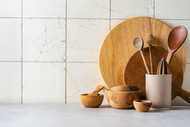
How to Avoid Microplastics in Home Cooking
May 10th 2024
You take the time to cook at home and prepare healthy meals, but what if nanoparticles like microplastics have found their way into your food?
Recent studies have revealed that exposure and consumption of nanoparticles like microplastics are capable of causing neurotoxicity and endocrine disruption leading to chronic health issues like type 2 diabetes and heart disease.
What Are Microplastics?
Microplastics are microscopic flakes or specks of plastic that end up in your food or drinks. Technically, any plastic less than 5 millimeters in length can be considered microplastic.
The University of Vienna published a study observing these particles crossing the blood-brain barrier, an important internal immune system function that helps to protect your brain from harmful substances.
This has led to an increased importance in understanding the harmful effects of microplastic consumption.
How Microplastics Get Into Your Food
Nobody has a home recipe that calls for a dash of microplastics, yet they’re incredibly common in many modern households. In fact, a study published in 2019 by the University of Victoria revealed that the average American consumes between 39,000-121,000 microplastics a year.
And while there are sensationalist stories of “fake rice”, the truth is that plastic nanoparticles may be entering your food in simpler ways than you would like to imagine.
Identifying Sources of Microplastics in Your Cooking
Actively choosing to avoid plastic in your kitchen is a skill that quickly develops because once you start spotting plastic sources in your kitchen it's hard to stop.Here are some of the most common places plastic is making its way into your cooking:
- Plastic cutting Boards
- Cooking Utensils (Spatulas, Ladles, Slotted Spoons) made from plastic
- Spice Storage
- Olive Oil Bottles
- Cling Wrap
- Tupperware
- Plastic Cups
- Coffee Thermos
- Instant or Highly Processed Foods
How to Eliminate Microplastics from Your Kitchen
Identifying the sources of microplastics in your kitchen is only the first step. The next step is finding suitable replacements for these items.
Natural Food Preparation Surfaces
One potentially major source of microplastics in your kitchen is your food preparation surfaces. If you’re using a plastic cutting board, especially one that is heavily scored from use, there is a strong possibility of microplastic exposure every time you cook.
There are two ways to approach this problem.
The first option is to replace your plastic cutting board with a hardwood cutting board. Maintained with a simple food-grade butcher block conditioning these cutting boards can last a lifetime, and you’ll eliminate plastic microparticle exposure from your cutting board completely.
As a second option, you can eliminate cutting boards entirely and save cabinet space by upgrading your current kitchen counters to a butcher block countertop.
Butcher block countertops can be used for food preparation, and give you more space to work with as you chop, slice, and dice various ingredients.
Many homeowners find a happy balance in replacing their kitchen island top with butcher block to turn it into a dedicated food preparation space. This eliminates your need for cutting boards with lower renovation cost and overall project time than a full butcher block countertop.
Natural Cooking Utensils
The second major source of microplastics in your kitchen is likely from any plastic kitchen utensils.
Plastic kitchen utensils have become common in kitchens, but if you’re serious about eliminating microplastics these should be some of the first things to go.
Plastic cooking utensils can be replaced with bamboo, stainless steel, or another wood. While you’ll still need to keep an eye on your utensils for signs of degradation, these options will eliminate plastics from your kitchen utensils.
Other Vital Replacements
For some items like spices and olive oil, you may need to commit to buying only glass bottles as transferring from a plastic bottle to a glass bottle isn’t going to do much to curb your exposure to microplastics. The oil or spices have already been shipped and stored in plastic for weeks and have been exposed to plastic nanoparticles.
Making more of these small changes alongside replacing your plastic cutting boards and cooking utensils with natural hardwood or bamboo options goes a long way in reducing your overall yearly microplastic consumption.
For example, a person that regularly drinks bottled water rather than filtered tap water consumes approximately 90,000 additional microplastics a year.
Avoiding Microplastics Made Easy
If you’re just starting the process of getting microplastics out of your kitchen, it’s easy to become overwhelmed. Our advice is to focus on one area first like your cutting boards.
Once you’ve completely eliminated microplastics from cutting boards, look to other areas where you can begin the process of replacing these items for healthier, more natural options.
Remember, any big or small changes you make will help to add up to fewer microplastics in your food. And it only gets easier as you continue to get these harmful materials out of your kitchen.





